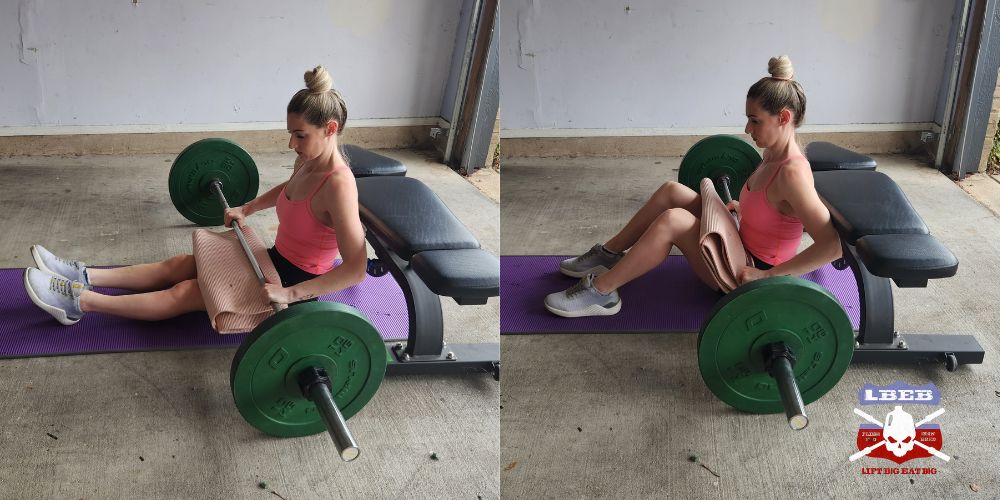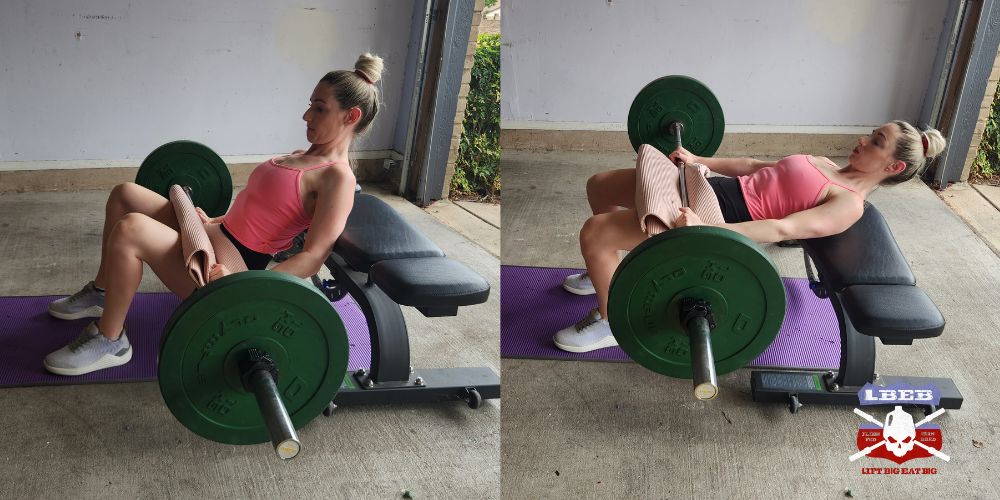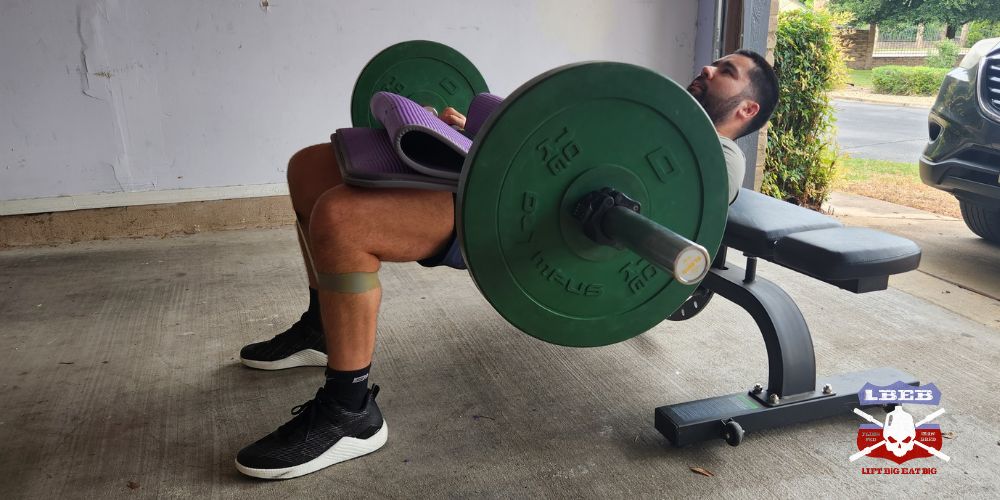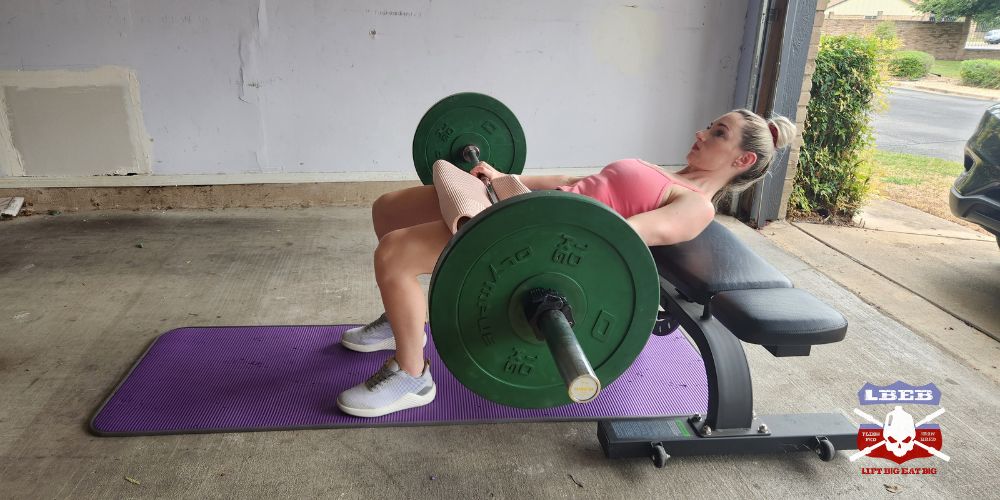The hip thrust is the bench press and biceps curl for women. You can’t walk into a gym without seeing lines of women performing the hip thrust. But it’s an excellent glute builder for men, so don’t label this as a “female exercise.”
But while it looks like a relatively straightforward exercise, some nuances turn the hip thrust from average to savage.
Table of Contents
How To Hip Thrust For Big Glutes
Step 1: The Setup

- The setup is the most tedious part of the hip thrust. Find a sturdy bench, a barbell, plates, and a foam pad to protect your hips.
- You will need to use 45 lb plates to raise the barbell high enough to roll over your legs while sitting on the floor with your back against the bench.
- Once the bar is on the foam pad over your hips, bend your legs so your feet are flat on the floor. Your hips will come off the floor slightly, and your shoulder blades will be against the bench. Hold the barbell so it’s not balancing on your hips.
Step 2: Thrust

- Drive through your heels and extend your hips. The characteristics of a well-executed hip thrust include vertical shins, tucked pelvis, and a slightly closed rib cage.
- A tucked pelvis, known as posterior pelvic tilt, will help engage the glutes and give you the biggest squeeze. Closing the rib cage so it’s not flared will do the same.
- Slowly lower your hips to the floor and repeat. Depending on your body structure, your hips may not reach the floor. This is fine.
When the hip thrust is performed correctly, you should only feel the exercise in your glutes, not your hamstrings. If you feel it mainly in your hamstrings, there are usually three issues:
- You’ve gone too heavy.
- Your feet are too far forward.
- Your lower back is arched, and your pelvis is anteriorly tilted.
Fix these things, and you’ll turn the hip thrust into a predominantly glute exercise. I cover many more tips in my “can’t feel glutes when hip thrusting” article here.
Hip Thrust Muscles Worked
The hip thrust is primarily a glute exercise since the glutes are the primary hip extensor. However, the hamstrings also play a role in hip extension but to a lesser degree in the hip thrust since the hamstrings are shortened.
More specifically, the most significant muscle activation is seen in the lower glutes, with the upper glutes not far behind [1].
Hip Thrust Benefits

Develop Huge Glutes
The main reason the hip thrust is used is to build bigger glutes. While the hip thrust elicits 3x greater glute activation than the squat, it doesn’t impact glute hypertrophy as squats and hip thrusts show similar gains in glute size [1][2].
Do More Volume With Less Fatigue
While squats and hip thrusts may lead to similar glute gains, the benefit of the hip thrust is being able to perform more volume without the same fatigue.
For example, 5 sets of 10 hip thrusts won’t leave you limping the next day, whereas the same set and rep scheme for the squat will destroy your legs for days. Therefore, you can get more glute volume within your training without negatively affecting other workouts.
No Compressive Loading
Traditional strength exercises that target the glutes are typically axially loaded. Meaning the load comes from the top down. Think of a barbell on your back pressing down or holding the top of a deadlift.
The hip thrust is loaded anteroposteriorly (front to back) on the hips eliminating the compressive forces on the spine. This is excellent news for anyone with back pain.
Lower Back Friendly
Some lifters will avoid squats and deadlifts because of lower back pain. Because of how the hip thrust is loaded, you don’t target the lower back. In my experience, it is an excellent exercise to work around back pain while building your glutes and hamstrings.
Hip Thrust Disadvantages

Hard To Setup
The major drawback to the hip thrust is the equipment and space required to set it up. In a busy commercial gym, it can be near impossible. You need to wheel a sturdy bench against a wall to keep it in place.
Then you must carry a barbell and plates to your workout area and find a barbell pad or mat thick enough to protect your hips.
Following this, sitting and rolling the barbell over your legs and wiggling into position can be uncomfortable.
Can Be Sore On The Hips
The hip thrust is almost undoable if you don’t have access to a pad. The pain of the barbell against your hips will reduce any glute sensation as you try to bear the pain.
Hip Thrust Workout
This workout targets the glutes and hamstrings that use the hip thrust as the main exercise.
A1) Hip Thrust 3 x 8, 1 x 15
B1) Back Squat 3 x 8
C1) Back Extension 2 x 20
D1) Glute Kickback 3 x 15-20
Hip Thrust Variations
Glute Bridge
The glute bridge is a variation requiring less equipment. Instead of propping against a bench, you lie flat on the floor. The glute bridge has less range of motion than the hip thrust and, in my experience, isn’t as good for glute development [3].
Even though the glute bridge elicits greater glute activation than the hip thrust [4], when choosing between the glute bridge and hip thrust, the hip thrust is a better option unless you have equipment limitations.
Hip Thrust w/ Band Around Knees
If you want to take the glute burn up a notch, adding a mini band around your knees challenges hip external rotation – another primary movement from the glutes. You must resist the band from pulling your knees together, simultaneously targeting hip extension and external rotation.
B Stance Hip Thrust
The B stance hip thrust is a relatively new hip thrust variation that emphasizes one leg instead of two. A B stance is a shorter staggered stance giving you the benefits of an almost bilateral exercise while putting more stress on one leg.
American Hip Thrust
The American hip thrust involves moving your body around the bench as you thrust. Instead of moving the hips vertically, you’ll push back against the bench toward to top, shortening the distance between the bench and the barbell.
I find you can get an immense glute contraction with this variation. The difference in setup is you’ll have your lower back against the bench and elbows on the bench.
Frequently Asked Hip Thrust Questions
What Is A Good Starting Weight For Hip Thrusts?
If you’re performing the barbell hip thrust, you’re limited to starting with at least 60 kg (135 lbs), as these are the only plates large enough to roll the barbell over your legs to get into position.
However, if you have a training partner that can deadlift the bar onto your hips or have access to bumper plates, then you can start at lighter loads.
Typically, you can hip thrust more than you squat and deadlift.
That doesn’t mean starting at loads above these numbers. Start with your first warm-up set weight you’d perform on these exercises, which would typically be 95 – 135 lbs.
Why Are Hip Thrusts So Popular Now?
Bret Contreras invented hip thrusts over a decade ago and has exploded in popularity because of social media influencers’ booty pictures and workouts, including theirs. Add to that the thousands of people who have grown their glutes using this exercise, and you have a recipe for virality.
Further, it’s an exercise you can lift heavy loads with, which makes social media posts more engaging.
What Are Hip Thrusts Good For?
Hip thrusts are good for strengthening hip extension and building the glutes. This is evidenced by similar glute gains compared to squats and similar improvements in deadlift numbers [2].
Should You Go Heavy On Hip Thrusts?
You can go heavy when hip thrusting, but there’s an easy way to tell if it’s too heavy. If you can’t feel your glutes and start to feel your hamstrings primarily when hip thrusting, it’s too heavy. You want to feel the glutes as the main muscle.
Summary
The hip thrust has become the most popular glute exercise and for a good reason. It primarily targets the glutes without leading to a lot of fatigue when performing volume. Further, you can load it heavier than squats and deadlifts.
References
1. Contreras, B., Vigotsky, A. D., Schoenfeld, B. J., Beardsley, C., & Cronin, J. (2015). A comparison of gluteus maximus, biceps femoris, and vastus lateralis electromyographic activity in the back squat and barbell hip thrust exercises. Journal of applied biomechanics, 31(6), 452-458.
2. Plotkin, D. L., Rodas, M. A., Vigotsky, A., McIntosh, M. C., Breeze, E., Ubrik, R., … & Roberts, M. D. (2023). Hip thrust and back squat training elicit similar gluteus muscle hypertrophy and transfer similarly to the deadlift. bioRxiv, 2023-06.
3. Zabaleta Korta, A. (2018). Biomechanical effects of Hip Thrust and Glute Bridge on hip extensors.
4. Kennedy, D., Casebolt, J. B., Farren, G. L., Fiaud, V., Bartlett, M., & Strong, L. (2022). Electromyographic differences of the gluteus maximus, gluteus medius, biceps femoris, and vastus lateralis between the barbell hip thrust and barbell glute bridge. Sports Biomechanics, 1-15.
